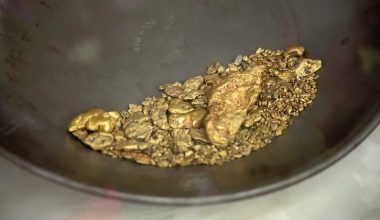Gold has been one of the most valuable and coveted metals for humanity since ancient times. Its beauty, rarity, and durability have made it a symbol of wealth and power. Throughout history, the price of gold has fluctuated due to various factors such as supply and demand, inflation, economic and political crises, among others. In this article, we will explore the evolution of gold prices throughout history, from antiquity to the present day, and analyze some key events that have influenced its value.
Reviving the Gold Rush: What Was the Price of the Precious Metal in 1980?
The gold rush is a phenomenon that has existed for centuries and has led thousands of people to seek fortune in mines. Today, the price of gold remains high, and many are interested in investing in it.
In 1980, the price of gold reached its historical peak of $850 per ounce. At that time, the market was in full swing, and many investors were eager to buy gold.
The increase in the price of gold occurred during a period of high inflation and economic crisis worldwide. Many investors saw gold as a way to protect their wealth from inflation and economic instability.
Although the price of gold has fluctuated since then, it remains considered a safe asset in times of economic uncertainty. Many people continue to invest in gold as a way to diversify their portfolios and protect their wealth.
In summary, the price of gold in 1980 reached its historical peak of $850 per ounce. Although there have been fluctuations, gold remains a popular and secure investment in times of economic uncertainty.
In a constantly changing world, the value of gold remains a constant. The gold rush may have diminished since the days of the mines, but the demand and interest in this precious metal remain high. What will be the future of the price of gold? Only time will tell.
The History of Gold: What Has Been Its Highest Price?
Gold has been valued for its beauty and rarity since ancient times. Throughout history, it has been used as currency and as a symbol of wealth and power.
The price of gold has fluctuated over the years, but one of the moments when it reached its highest price was during the 2008 financial crisis. In September of that year, the price of gold reached $1,900 per ounce.
This record price was largely due to the economic and political uncertainty prevailing at that time. Investors sought refuge in gold as a safe way to protect their wealth.
Although the price of gold has declined since then, it remains a valuable asset and a popular investment. The price of gold fluctuates daily based on various factors, such as demand, supply, and inflation.
In summary, gold has been an important part of human history, and its value has fluctuated over the years. What will be its maximum price in the future? Only time will tell.
The Price of Gold in 2000: How Much Was It Worth, and How Has It Evolved Since Then?
In the year 2000, the price of gold was around $280 per ounce. Since then, the price of gold has experienced a consistent upward trend with some fluctuations.
In 2011, the price of gold reached its historical peak of $1,920 per ounce due to economic uncertainty and demand from investors seeking a safe investment in times of crisis.
In the following years, the price of gold fluctuated between $1,000 and $1,500 per ounce but remained relatively high compared to its price two decades ago.
The evolution of the price of gold has been influenced by various factors, such as investor demand, central bank monetary policy, inflation, and changes in the value of the U.S. dollar.
Although the price of gold has experienced some declines, it remains a popular investment for those seeking a safe and stable asset in times of economic uncertainty.
In summary, the price of gold in 2000 was around $280 per ounce, and since then, it has experienced a consistent upward trend with some fluctuations. It is a popular asset among investors seeking a safe and stable investment in times of economic uncertainty.
The Price of Gold in 2010: What Factors Influenced Its Valuation?
The price of gold in 2010 was a matter of great interest for many investors and economists worldwide. Throughout that year, the value of gold experienced an upward trend that led to record figures.
One of the main factors that influenced the valuation of gold in 2010 was global economic instability, especially in Europe and the United States. Many investors and central banks sought refuge in gold as a safe and stable asset amid financial uncertainty.
Another important factor was the weakness of the U.S. dollar since gold is quoted in U.S. dollars. When the dollar depreciates, the price of gold tends to rise, which partly explains the increase in the value of the precious metal during this period.
Furthermore, the high demand for gold in countries such as China and India also contributed to the price increase in 2010. These countries are major consumers of gold for use in jewelry and as an investment, boosting the global demand for the precious metal.
In summary, the price of gold in 2010 was influenced by various factors, including economic instability, the weakness of the U.S. dollar, and high demand in Asian countries. Today, the value of gold remains an important indicator of global economic health and continues to be a popular asset for investors.
It is interesting to see how these factors continue to influence the valuation of gold today and how demand and the value of the precious metal can change in response to global economic events.
Gold Consolidates as a Safe Haven: Its Price Triples in the Last 20 Years
Gold has always been considered a safe haven asset in times of economic and political crisis. In the last 20 years, its price has tripled, further solidifying its status as a secure investment.
The demand for gold has increased in recent years due to instability in financial markets and geopolitical tensions. Investors seek to protect their capital and look for assets that provide stability.
The rise in the price of gold is also due to the scarcity of the metal. Gold production has decreased in recent years, leading to an increase in its value.
In addition to being a safe haven asset, gold has multiple industrial uses and is used in the manufacture of jewelry and coins. This further increases its demand.
In conclusion, gold has solidified its status as a safe haven asset in recent years due to economic and political instability. Its price has increased due to the scarcity of the metal and its industrial use.
It is interesting to reflect on how the search for stability and security in times of uncertainty has caused the value of gold to increase. Will gold continue to be a safe haven asset in the future, or will new investment alternatives emerge in times of crisis?
In conclusion, the price of gold has been a historical variable of great importance and has evolved according to the needs and demands of each era. From its use as currency to its role as a safe haven asset in times of economic uncertainty, gold has been a constant element in human history.
We hope that this article has been of interest to you and has allowed you to learn more about the evolution of gold prices throughout history. Until next time!

